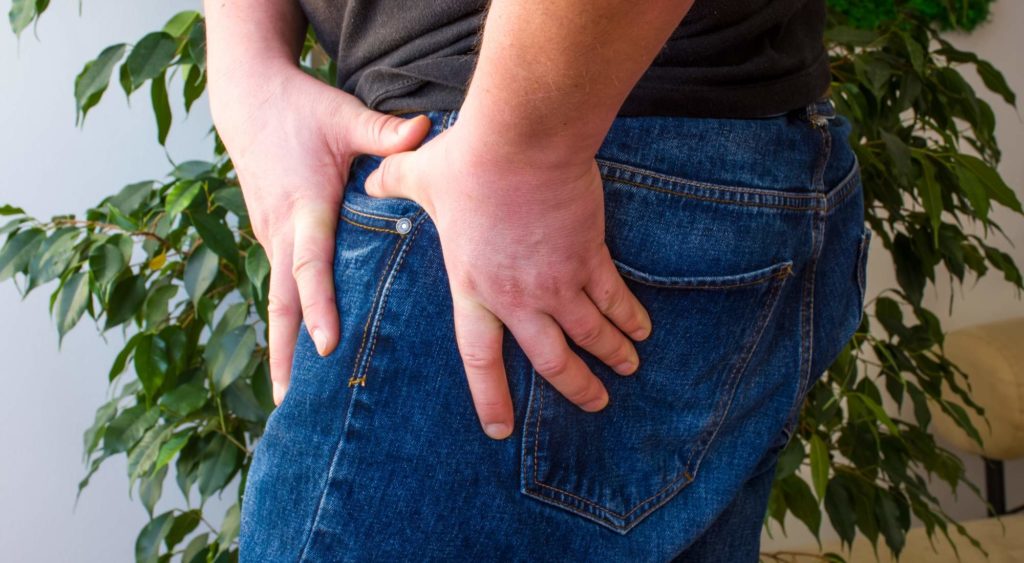Hip Bursitis Physical Therapy

Physical Therapy for Hip Bursitis – Information, Exercises, and More
You have joint pain and tenderness. Maybe it’s a sharp pain that stops you in your tracks.
Your pain can last from a few hours to several weeks. You want relief—now.
The good news is that there are many tried and tested techniques that can help with your pain. You’re not alone.
Let’s look at:
- What causes your pain
- Common symptoms
- How physical therapy can help
- Exercises you may be able to do at home

What is Hip Bursitis?
Hip bursitis is a painful condition caused by inflammation of a bursa in your hip.
These fluid-filled sacs (bursae) in your hip cushion your tendons, ligaments, and muscles.
When they work normally, bursae help your tendons, ligaments, and muscles to glide smoothly over the bone.
But when they become swollen, watch out.
Your hip bursitis can be caused by things like:
- Inactivity or muscle weakness
- A pinched nerve in the lower back
- Injury
- Disease
We’ll be focusing on your hip bursitis (as well as looking at other causes), but bursitis can also occur in the shoulder, knee, and elbow joints.
What Causes Hip Bursitis?
When the bursae are swollen, the area around them becomes very tender and painful.
The swelling affecting the bursae of the hip is also called trochanteric bursitis.
Several things can cause Hip Bursitis, including:
- Repeated overuse or stress of your hip
- Rheumatoid arthritis
- Gout
- Injury of the hip
- Infection (such as a staph infection)
- Diabetes
- Uneven leg lengths
- Spine problems (such as scoliosis)
- Spine disease
- Bone spurs on your hip
There are two causes that are the most common:
- Inactivity or muscle weakness
- You can develop Hip Bursitis after a period of illness or inactivity. The abductor muscles may become weak and trigger increased pressure on the bursa.
- Pinched nerves in the lower back
- This can cause weakness of the abductor muscles and contribute to developing hip bursitis.
Hip Bursitis Symptoms
The first symptom of hip bursitis is usually joint pain and tenderness. You may also see swelling and your hip may feel warm to the touch.
Hip bursitis can also result in pain in your groin region.
Some describe the pain as sharp in the first few days, and then it can become dull and achy later.
Your pain may feel worse when doing things like:
- Getting up from a chair
- Getting out of bed
- Lying on the affected side
Your hip bursitis may be acute or chronic.
Acute hip bursitis usually flares over hours or days. It can become chronic if it comes back or if a hip injury occurs.
Chronic bursitis can last from a few days to several weeks. It can go away and come back again.
Over time, hip bursitis can lead to limited movement and weakened muscles in the area if the swelling becomes worse.
Diagnosing Hip Bursitis
Your doctor will examine you and ask about your symptoms.
Tenderness and swelling in the area over the bursa during your examination typically confirms the diagnosis of hip bursitis.
Further testing may be needed to rule out other conditions or to check for bone spurs.
Your doctor may order 1 or both of these tests:
- X-ray
- To check for bone spurs.
- MRI
- To view soft tissues and structures not visible on an X-ray.
Hip Bursitis Treatment
Hip bursitis treatments are focused on resolving your inflammation and pain as well as strengthening your hip abductor muscles.
This usually involves physical therapy with strengthening exercises and stretching to help prevent muscle atrophy.
Your doctor may also prescribe anti-inflammatory medications to reduce inflammation and pain. An ice pack can also help with swelling.
An injection of corticosteroid into the bursa may reduce inflammation and pain. Multiple injections are sometimes needed if the pain returns.
Surgery for Hip Bursitis is rarely needed. It’s the last resort when all other treatments fail.
If surgery is needed, the doctor may remove the bursa from the hip or shave the outside of the bone to create a smoother surface.
Hip Bursitis Physical Therapy – Will PT Help?
Can physical therapy help your Hip Bursitis?
Absolutely.
Physical therapy can help you move like you did before you developed hip bursitis. This is especially true if you have chronic hip bursitis.
Your physical therapist will work with you on the best course of action for your hip bursitis. He or she will evaluate your mobility, flexibility, and strength.
Many therapists will follow a treatment plan for hip bursitis physical therapy that includes:
- Muscle strengthening exercises
- Treatment with heat
- Treatment with ice
- Ultrasound treatments
Your physical therapist should instruct you on which activities you can safely continue and which you should avoid.
You may also be given exercises to perform at home.
Best Hip Bursitis Exercises
Wondering if you should continue exercising with hip bursitis?
With the “OK” from your doctor or physical therapist, you can likely continue to exercise with hip bursitis at home. The right exercises can help you increase the tone of your hip muscles.
For any exercises that you begin, start slowly. Ease off the exercises or stretches if you start to have pain.
If you’re seeing a physical therapist, you’ll be given exercises that are specific for your hip bursitis condition.
Some exercises may work better for different patients.
Some popular home exercises include:
- Hip rotator stretch
- Iliotibial band stretch
- Straight-leg raises to the outside
- Clamshell
How In Motion O.C. Can Help With Hip Bursitis
In Motion O.C. is rated as the #1 physical therapist in the entire country on Yelp! for a reason.
We care about you. We care about your pain. We are on a mission to help you.
Our mission statement is to bring hope, healing, confidence, and joy to others.
We’ve helped hundreds of patients just like you. Give us a call today to schedule your consultation.
*This information about physical therapy for Hip Bursitis was reviewed by Dr Natalie Thomas, PT, DPT. If you have any questions, please don’t hesitate to contact us here.


